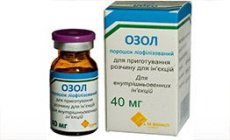Medical expert of the article
New publications
Preparations
Ozol
Last reviewed: 03.07.2025

All iLive content is medically reviewed or fact checked to ensure as much factual accuracy as possible.
We have strict sourcing guidelines and only link to reputable media sites, academic research institutions and, whenever possible, medically peer reviewed studies. Note that the numbers in parentheses ([1], [2], etc.) are clickable links to these studies.
If you feel that any of our content is inaccurate, out-of-date, or otherwise questionable, please select it and press Ctrl + Enter.

Ozol belongs to the pharmacological group of antiulcer drugs-proton pump inhibitors used in acid-dependent diseases of the gastrointestinal tract. Other trade names of the drug: Omeprazole, Omeprol, Omez, Omizak, Losek, Gasek, Ultop, etc.
 [ 1 ]
[ 1 ]
Indications Ozol
Ozol is used in complex therapy:
- gastric ulcer and duodenal ulcer (including to prevent relapses);
- peptic ulcers of the digestive system;
- gastroesophageal reflux disease;
- ulcerogenic adenoma of the pancreas (Zollinger-Ellison syndrome);
- other digestive disorders (including iatrogenic gastropathy) occurring against the background of gastric hypersecretion.
 [ 2 ]
[ 2 ]
Release form
Release form: lyophilized powder for preparation of injection solution, in vials of 40 mg.
 [ 3 ]
[ 3 ]
Pharmacodynamics
Pharmacodynamics Ozol is provided by the active substance - omeprazole (a benzimidazole derivative), which, when entering the acidic environment of the stomach, is converted into active metabolites - cyclic sulfenamides.
Accumulating in the secretory canals of the parietal cells of the gastric mucosa, the active substances (sulfonomeprazole) bind to the protein of the cell membranes H+/K+ -ATPase (hydrogen-potassium adenosine triphosphatase or proton pump) and completely block the work of this enzyme. As a result, the transmembrane transfer (pumping) of sodium (Na+) and potassium (K+) protons in the cells stops and the normal functioning of the cells that synthesize HCl is disrupted.
And thus the process of both spontaneous and stimulated production of hydrochloric acid by the parietal cells of the stomach is reversibly suspended.
Pharmacokinetics
After entering the body, Ozol is absorbed in the small intestine and enters the bloodstream; the maximum content of the drug in the blood plasma is observed on average after 0.5-3 hours; systemic bioavailability with intravenous administration is at the level of 98%.
The degree of binding to plasma proteins reaches 90%, part of the drug penetrates the hematoplacental barrier.
Ozol is metabolized in the liver; 80% of metabolites are excreted from the body by the kidneys - with urine, the rest - by the intestines with excrements. The half-life is about 45-50 minutes. The drug does not accumulate in the body.
Dosing and administration
The lyophilized powder should be mixed with the solvent supplied with the preparation (10 ml); the resulting solution is administered intravenously (slowly). The maximum shelf life of the prepared solution is 4 hours.
The dose and duration of therapy are prescribed individually depending on the diagnosis. The standard dosage for exacerbation of gastric ulcer and duodenal ulcer (in cases of difficulties with taking generic drugs in tablet form) is 40 mg once a day; for gastroesophageal reflux disease - 40 g (single dose); for Zollinger-Ellison syndrome - 60 mg per day.
Use Ozol during pregnancy
The use of Ozol during pregnancy is contraindicated.
Side effects Ozol
Possible side effects of Ozol include headache, abdominal pain, joint or muscle pain; dry mouth and taste disturbances; diarrhea or constipation, sleep disturbances.
Local swelling, urticaria, hyperemia and itching of the skin; increased sweating and increased body temperature; deterioration of vision; decreased levels of leukocytes and platelets in the blood; kidney inflammation may also be observed.
Interactions with other drugs
The use of Ozol simultaneously with clarithromycin increases the concentration of both drugs in the blood plasma; simultaneously with diazepam, warfarin or phenytoin - increases the concentration of these drugs and reduces the rate of their elimination.
Ozol can also impair the absorption of ketoconazole, itraconazole and iron preparations.
Storage conditions
Storage conditions for Ozol: in a place protected from light and moisture, at a temperature of + 15-25°C.
Shelf life
Shelf life: 24 months.
 [ 35 ]
[ 35 ]
Attention!
To simplify the perception of information, this instruction for use of the drug "Ozol" translated and presented in a special form on the basis of the official instructions for medical use of the drug. Before use read the annotation that came directly to medicines.
Description provided for informational purposes and is not a guide to self-healing. The need for this drug, the purpose of the treatment regimen, methods and dose of the drug is determined solely by the attending physician. Self-medication is dangerous for your health.

